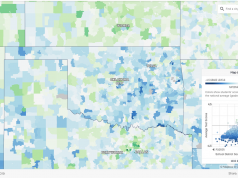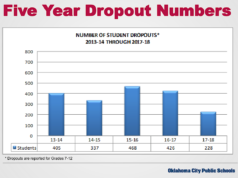
When a new mass charterization plan was presented to the Oklahoma City Public School System Board of Education last week, “tempers flared … and a standing room-only crowd cheered and jeered,” according to NewsOK’s Tim Willert.
The “Quality Seats Program,” as it has been branded, is a risky effort to expand OKC charters, and it is doubly disappointing.
First, it doesn’t resemble an actionable education plan. The proposal to expand charters doesn’t look like an effort to improve schools as much as it appears to be a payday loan for getting past the budget crisis by treating up to one-eighth of the OKCPS as collateral.
The district apparently would replace neighborhood schools with charters to “… solicit more corporate support … that will alleviate some of the strain on the district to come up with operational money,” according to another NewsOK article from their education reporter.
The most likely result would be the failure of a number of hastily created charter schools and an exodus of poor children of color from near-downtown schools to already overburdened high-poverty schools. (Of course, that would increase property values around downtown … .)
Second, the mass charterization plan doesn’t even distinguish between what it takes to run a low-poverty charter like John Rex Charter Elementary School (which is only 40 to 44 percent low-income and which only has 3 percent of its students on special-education IEPs, or individual education plans) and what it takes to improve 97-percent or 100-percent low-income schools.
Oklahoma City has been relatively slow to embrace the dangerous risk-taking of venture philanthropists. Still, across the nation, teachers, unions, school boards and social scientists are no longer seen as mere opponents, but rather as outright enemies. Rather than compromise or invest in individual locally grown charters, venture philanthropists use school closures and mass charterizations as weapons to drive unions and veteran teachers (who earn higher wages, receive benefits and possess a resistance to drill-and-kill teaching strategies) out of the field.
‘Liberal PTSD’ as the origin of venture philanthropy
The best explanation of the origins of the national, contemporary education reform movement comes from the New York Times Magazine’s Paul Tough, who said the movement’s origin was “liberal PTSD” from supposedly losing the War on Poverty. “Output-driven” reformers (who knew virtually nothing about inner-city schools) concluded that old-fashioned, incremental school improvement sounded too wimpy. To get the public support required for “transformative” or “disruptive” change and to “blow up” the education “status quo,” they committed to the tougher-sounding, accountability-driven approach to reform.
In actuality, America didn’t lose the War on Poverty. It failed at the goal of transformative change but produced real gains for poor people. Moreover, student performance increased more in the decades before test-driven, data-driven reform than it did after billions of dollars of competition-driven policies were imposed. Reformers sought “disruptive innovation” to blow up local school governance, teachers unions and university education programs in the faith that the Market would replace them with something better. Essentially, it has not.
Liberal reform group the Education Trust captured the essence of test, sort, reward and punish school improvement strategies when it attacked the journal of record, Education Week, and its publication of studies by the Pew Trust and the Casey Foundation on the role of poverty in undermining inner-city education.
The Education Trust ridiculed the education journal, asking whether it was “Education Week” or “Sociology Week.” The mere mention of poverty was derided by liberal reformers as claiming that “demography is destiny” and by conservative reformers as the “benign bigotry of low expectations.” Calls for early education and wraparound services for poor children were lambasted as “low expectations” and “excuses.”
The ‘bad teacher’ narrative
Seeking a quicker and easier shortcut to school improvement, reformers “deputized” teachers as the agents for overcoming the legacies of poverty, trauma and oppression. Test-driven, competition-driven reformers often made it a point of pride that they ignored a huge body of social and cognitive science that explained why their silver bullets would almost certainly fail.
As the movement morphed into “corporate reform,” the best public relations spin that the billionaires’ money could buy developed the “bad teacher” narrative: Defeat the unions that supposedly protected bad teachers (who supposedly could have overcome poverty but chose not to) and schools could be improved on the cheap. After the full corporate-reform agenda was imposed, this silver bullet was no longer cheap.
The tens of billions of additional dollars that were invested in defeating unions, firing teachers and creating incentives produced a colossal failure. As Paul Tough and others explain, schools that employ the Knowledge Is Power Program (which doesn’t attempt to teach any more of the high-challenge students than they can handle) proved beneficial to a tiny minority of poor kids.

MAPS for Kids: A compassionate throwback
It was the late John Rex who taught me the importance of high-quality early education. When I served on the MAPS for Kids Steering Committee and its Student Achievement and Community Outreach committees, I was proud to see that the Oklahoma City business leaders adopted a view that was far more compassionate than corporate reformers in most of the country.
Before MAPS, most of my students had attended Western Village, which was then the lowest-ranked elementary school in the state. INTEGRIS Hospital and other donors did not impose the mass dismissal of veteran teachers or the soul-killing “teach to the test” business model that is now the norm.
Hupfeld Academy found success in providing between 269 to 300 mentors to assist in the educations of about 330 students. Neither did it follow the path of creating pedagogies that drive unconscionable numbers of students from school, which now is quite common among high-poverty charters. Even Hupfeld, however, has an incredibly low percentage of special education students at only 3.6 percent.
I wish we could return to the days of MAPS for Kids when we rejected scorched-earth politics. Teachers and unions supported Hupfeld Academy and the downtown charter, but No Child Left Behind arrived and things changed, to say the least. Eventually, schools like Oklahoma City’s KIPP became a rare exception, and No Excuses charters became increasingly brutal as they attempted to post higher test scores than neighborhood schools. Even in Oklahoma City, we started to blame each other (as opposed to federal micromanaging) for the disappointing results in the OKCPS.
If we could turn the clock back to ancient history — i.e. the MAPS era — we could draw upon what worked at Hupfeld Academy and discuss what we have since learned about improving that science-based approach. I would gladly listen to reformers who disagree with me on that, and any other issue. In return, I would explain why teachers unions are even more important today. I’d also like to explain why I believe that the mass pushing out of students is inevitable in today’s edu-political climate: Educators must have due process rights before honest information will be allowed up the chain of command.
A high-stakes gamble
If we teachers fail to convince donors and individual schools reject the union, then that’s life. As we have always done, teachers and unions will move on to other issues and seek agreements on other ways of helping our kids (as we resist any new waves of mass charterization). If more parents listened to both sides of the issue and chose No Excuses instruction, of course, we would respect that, too.
But educators and families can’t sit quietly by while non-educators — who are as sincere as they are ill-informed about urban education — conduct this grand experiment on our kids. I sincerely hope we can have evidence-based discussion before engaging in such a high-stakes gamble that could be devastating for our kids and the OKCPS.






















